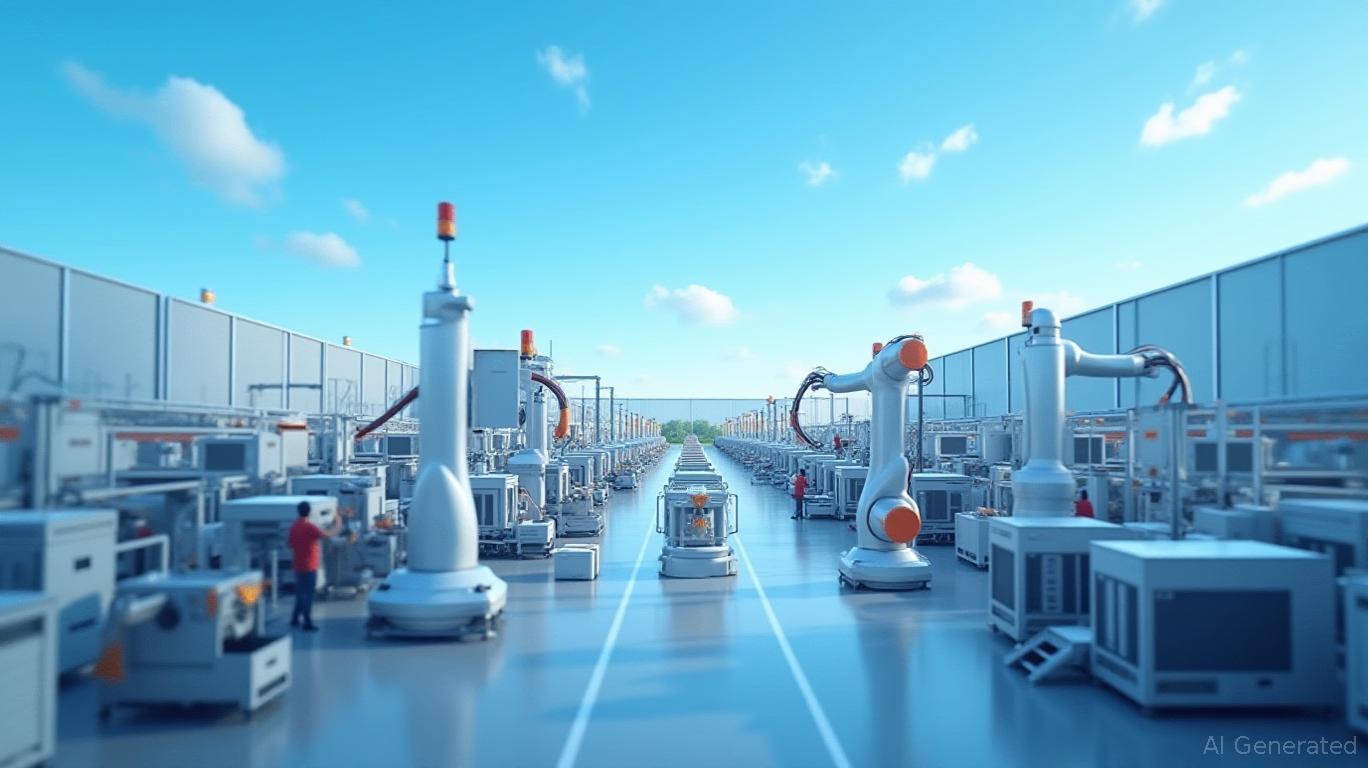Jabil Circuit: Navigating AI and Infrastructure Growth with Strategic Resolve
The electronics manufacturing services (EMS) sector faces a pivotal
, shaped by the accelerating demand for artificial intelligence (AI) infrastructure, cloud computing, and advanced manufacturing technologies. Jabil Circuit's fiscal third-quarter 2025 results and strategic moves underscore its ability to capitalize on these trends while maintaining financial discipline. For investors, the company's performance and bold capital allocation decisions warrant close scrutiny as it positions itself as a leader in a rapidly evolving industry.Q3 Results: A Foundation for Momentum
Jabil delivered a robust third quarter, reporting net revenue of $7.83 billion, a 16% year-over-year increase and a clear beat of consensus estimates. While its gross margin dipped to 8.7% (from 11.2% in Q3 2024), this reflects strategic investments in high-growth markets, including the ramp-up of advanced manufacturing capabilities for AI-driven infrastructure. The Intelligent Infrastructure segment, which now accounts for over 40% of revenue, surged 54% year-over-year, fueled by demand for cloud servers, data center hardware, and capital equipment.
The company's core diluted EPS (non-GAAP) rose to $2.55, exceeding forecasts and marking a 35% year-over-year improvement. This outperformance, coupled with an upward revision of its full-year 2025 guidance—projecting $29 billion in net revenue and $9.33 in core EPS—signals confidence in its ability to sustain momentum.

The $500 Million U.S. Investment: A Strategic Masterstroke?
The announcement of a $500 million U.S. expansion, targeting cloud and AI data center infrastructure, is a defining move. The funds will support new manufacturing capabilities, workforce development, and partnerships with firms like AVL (automotive technology) and Badger Technologies (AI-driven logistics). By 2026, these facilities are expected to solidify Jabil's position as a domestic supplier of critical infrastructure, leveraging geopolitical tailwinds such as U.S. incentives for onshore production.
This investment aligns with two critical trends:
1. AI Infrastructure Demand: The global AI hardware market is projected to grow at a 17% CAGR through 2030, driven by hyperscalers like Amazon, Google, and Microsoft. Jabil's partnership with Mikros Technologies—a leader in liquid cooling solutions—positions it to capture this demand.
2. Supply Chain Resilience: The shift toward regionalized manufacturing, amplified by trade tensions and logistics costs, favors EMS providers with U.S.-based capacity.
The move also mitigates risks tied to geopolitical instability and supply chain bottlenecks. However, execution is key: the company must avoid overextending into capital-intensive projects while maintaining its focus on margin improvement.
Competitive Positioning: Strengths and Weaknesses
Jabil's diversified portfolio and operational agility set it apart from peers like Flex Ltd (FLEX) and Celestica (CLS). Its Intelligent Infrastructure segment's growth outpaces the EMS sector average, and its acquisitions in photonics (e.g., 1.6T pluggable transceivers) and healthcare (Pharmaceutics International, Inc.) diversify risk.
Yet challenges persist:
- Sector Softness: Weakness in EVs, renewables, and 5G—segments where peers like Flex are stronger—could constrain revenue growth.
- Margin Pressures: The gross margin contraction highlights the trade-off between scale and profitability in high-volume, low-margin segments.
Investor Appeal: Risks and Rewards
For investors, Jabil's valuation appears reasonable at 17x forward P/E (vs. 19x for Flex), but its balance sheet remains a concern. Cash reserves have dipped to $1.52 billion, partly due to share repurchases ($339 million in Q3) and acquisitions. While the company aims to generate $1.2 billion in adjusted free cash flow for FY2025, capital-heavy investments could strain liquidity.
Buy Signal:
- Catalysts: Execution of the U.S. expansion, AI infrastructure wins, and margin recovery in Intelligent Infrastructure.
- Valuation: Attractive multiple compression potential if margins stabilize.
Hold Signal:
- Risks: Supply chain disruptions, EV/renewables market volatility, and geopolitical headwinds.
Historical performance of a buy-and-hold strategy based on earnings beats suggests caution. A backtest from 2020 to 2025 showed that buying JBL when it beat estimates and holding for 30 days resulted in a CAGR of 9.31%, significantly underperforming the benchmark with an excess return of -34.93%. The low Sharpe ratio of 0.45 highlights the strategy's poor risk-adjusted returns. This underscores the importance of considering execution risks and market conditions when adopting such a strategy.
For investors, Jabil's valuation appears reasonable at 17x forward P/E (vs. 19x for Flex), but its balance sheet remains a concern.
Conclusion: A Long-Term Play on Tech Infrastructure
Jabil's fiscal third-quarter results and strategic moves reflect a company in transition—one pivoting from commodity EMS to high-margin, capital-intensive markets. The $500 million U.S. investment is a bold bet on AI and cloud infrastructure, sectors with multiyear growth trajectories. While near-term risks remain, the company's execution in diversifying its revenue streams and its focus on operational excellence position it as a compelling long-term investment in the EMS space.
For investors seeking exposure to the AI revolution and resilient supply chains, Jabil's stock merits a place in a diversified portfolio—provided one is prepared to endure short-term volatility.
Disclaimer: This analysis is for informational purposes only and should not be construed as investment advice. Always conduct independent research or consult a financial advisor.

Comments
No comments yet